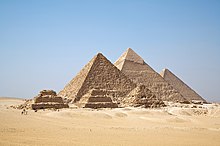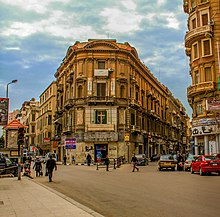


There have been many architectural styles used in Egyptian buildings over the centuries, including Ancient Egyptian architecture, Greco-Roman architecture, Islamic architecture, and modern architecture.
Ancient Egyptian architecture is best known for its monumental temples and tombs built in stone, including its famous pyramids, such as the pyramids of Giza. These were built with a distinctive repertoire of elements including pylon gateways, hypostyle halls, obelisks, and hieroglyphic decoration. The advent of Greek Ptolemaic rule, followed by Roman rule, introduced elements of Greco-Roman architecture into Egypt, especially in the capital city of Alexandria. After this came Coptic architecture, including early Christian architecture, which continued to follow ancient classical and Byzantine influences.
Following the Muslim conquest of Egypt in the 7th century, Islamic architecture flourished. A new capital, Fustat, was founded; it became the center of monumental architectural patronage thenceforth, and through successive new administrative capitals, it eventually became the modern city of Cairo. Early Islamic architecture displayed a mix of influences, including classical antiquity and new influences from the east such as the Abbasid style that radiated from the Abbasid Caliphate's heartland in Mesopotomia (present-day Iraq) during the 9th century. In the 10th century, Egypt became the center of a new empire, the Fatimid Caliphate. Fatimid architecture initiated further developments that influenced the architectural styles of subsequent periods. Saladin, who overthrew the Fatimids and founded the Ayyubid dynasty in the 12th century, was responsible for constructing the Cairo Citadel, which remained the center of government until the 19th century. During the Mamluk period (13th–16th centuries), a wealth of monumental religious and funerary complexes were built, constituting much of Cairo's medieval heritage today. The Mamluk architectural style continued to linger even after the Ottoman conquest of 1517, when Egypt became an Ottoman province.
In the early 19th century, Muhammad Ali began to modernize Egyptian society and encouraged a break with traditional medieval architectural traditions, initially by emulating late Ottoman architectural trends. Under the reign of his grandson Isma'il Pasha (1860s and 1870s), reform efforts were pushed further, the Suez Canal was constructed (inaugurated in 1869), and a new Haussmann-influenced expansion of Cairo began. European tastes became strongly evident in architecture in the late 19th century, though there was also a trend of reviving what were seen as indigenous or "national" architectural styles, seen in the many "neo-Mamluk" buildings of this era. In the 20th century, some Egyptian architects pushed back against dominant Western ideas of architecture. Among them, Hassan Fathy was known for adapting indigenous vernacular architecture to modern needs. Since then, Egypt continues to see new buildings erected in a variety of styles and for various purposes, ranging from housing projects to more monumental prestige projects like the Cairo Tower (1961) and the Bibliotheca Alexandrina (2002).
- ^ Behrens-Abouseif 1989, pp. 58–62.
